Quantitative Analysis of the Determinants Influencing Urban Expansion: A Case Study in Beijing, China
Abstract
:1. Introduction
2. Materials and Methods
2.1. Study Area
2.2. Potential Driving Forces and Data Sources
2.3. Methods
2.3.1. Measuring Urban Expansion
2.3.2. Modeling Using GeoDetector
- Enhance:
- Bi-enhance:
- Enhance, nonlinear-:
- Weaken:
- Weaken, uni-enhance:
- Weaken, nonlinear-:
- Independent:
2.3.3. GeoDetector Modifiable Areal Unit Problem (MAUP)
3. Results and Analysis
3.1. GeoDetector MAUP
3.2. Spatial Structural Evolution of Urban Expansion in Beijing
3.3. Analysis of the Determinants of Urban Expansion in Beijing
3.3.1. Which Determinants Are Responsible for Beijing’s Urban Expansion?
3.3.2. What Is the Relative Importance of Urban Expansion for Each Determinant Stratum?
3.3.3. Whether the Driving Forces of Urban Expansion Are Independent of or Dependent on One Another?
4. Discussion
5. Conclusions
Author Contributions
Funding
Conflicts of Interest
References
- Department of Economic and Social Affairs. World Urbanization Prospects: The 2014 Revision. Available online: https://esa.un.org/unpd/wup/Publications/Files/WUP2014-Report.pdf (accessed on 11 March 2016).
- Development Planning Division, National Development and Reform Commission (NDRC), People´s Republic of China. National New Urbanization Plan (2014–2020). Available online: http://ghs.ndrc.gov.cn/zttp/xxczhjs/ghzc/201605/t20160505_800839.html (accessed on 27 April 2018).
- Clarke, K.C.; Gaydos, L.J. Loose-coupling a cellular automaton model and GIS: Long-term urban growth prediction for San Francisco and Washington/Baltimore. Int. J. Geogr. Inf. Sci. 1998, 12, 699–714. [Google Scholar] [CrossRef] [PubMed]
- Meentemeyer, R.K.; Tang, W.; Dorning, M.A.; Vogler, J.B.; Cunniffe, N.J.; Shoemaker, D.A. Futures: Multilevel simulations of emerging urban–rural landscape structure using a stochastic patch-growing algorithm. Ann. Assoc. Am. Geogr. 2013, 103, 785–807. [Google Scholar] [CrossRef]
- Jiang, L.; Deng, X.; Seto, K.C. Multi-level modeling of urban expansion and cultivated land conversion for urban hotspot counties in china. Landsc. Urban Plan. 2012, 108, 131–139. [Google Scholar] [CrossRef]
- Dewan, A.M.; Yamaguchi, Y. Land use and land cover change in Greater Dhaka, Bangladesh: Using remote sensing to promote sustainable urbanization. Appl. Geogr. 2009, 29, 390–401. [Google Scholar] [CrossRef]
- De la Luz Hernández-Flores, M.; Otazo-Sánchez, E.M.; Galeana-Pizaña, M.; Roldán-Cruz, E.I.; Razo-Zárate, R.; González-Ramírez, C.A.; Galindo-Castillo, E.; Gordillo-Martínez, A.J. Urban driving forces and megacity expansion threats. Study case in the Mexico City periphery. Habitat Int. 2017, 64, 109–122. [Google Scholar] [CrossRef]
- Estoque, R.C.; Murayama, Y. Landscape pattern and ecosystem service value changes: Implications for environmental sustainability planning for the rapidly urbanizing summer capital of the Philippines. Landsc. Urban Plan. 2013, 116, 60–72. [Google Scholar] [CrossRef]
- Liu, J.; Zhan, J.; Deng, X. Spatio-temporal patterns and driving forces of urban land expansion in China during the economic reform era. AMBIO 2005, 34, 450–455. [Google Scholar] [CrossRef] [PubMed]
- Xiao, J.; Shen, Y.; Ge, J.; Tateishi, R.; Tang, C.; Liang, Y.; Huang, Z. Evaluating urban expansion and land use change in Shijiazhuang, China, by using GIS and remote sensing. Landsc. Urban Plan. 2006, 75, 69–80. [Google Scholar] [CrossRef]
- Li, X.; Zhou, W.; Ouyang, Z. Forty years of urban expansion in Beijing: What is the relative importance of physical, socioeconomic, and neighborhood factors? Appl. Geogr. 2013, 38, 1–10. [Google Scholar] [CrossRef]
- Zhang, Y.; Gong, H.; Zhao, W.; Li, X. Analyzing the mechanism of land use change in Beijing city from 1990 to 2000. Resour. Sci. 2007, 29, 206–213. [Google Scholar]
- Zhang, Z.; Su, S.; Xiao, R.; Jiang, D.; Wu, J. Identifying determinants of urban growth from a multi-scale perspective: A case study of the urban agglomeration around Hangzhou Bay, China. Appl. Geogr. 2013, 45, 193–202. [Google Scholar] [CrossRef]
- Su, S.; Xiao, R.; Jiang, Z.; Zhang, Y. Characterizing landscape pattern and ecosystem service value changes for urbanization impacts at an eco-regional scale. Appl. Geogr. 2012, 34, 295–305. [Google Scholar] [CrossRef]
- Quan, Q.; Tian, G. A gradient analysis of spatiotemporal changes of urban landscape pattern in Beijing metropolitan region by GIS. Ecol. Sci. 2008, 27, 254–261. [Google Scholar]
- Long, Y.; Gu, Y.; Han, H. Spatiotemporal heterogeneity of urban planning implementation effectiveness: Evidence from five urban master plans of Beijing. Landsc. Urban Plan. 2012, 108, 103–111. [Google Scholar] [CrossRef]
- Daquan, H.; Jin, H.; Zhao, X. Determinants of land conversion to urban uses in Changping district, Beijing. Resour. Sci. 2014, 36, 454–462. [Google Scholar]
- He, C.; Shi, P.; Chen, J.; Xu, X. Process and mechanism of urbanization in Beijing area. Acta Geogr. Sin. 2002, 57, 363–371. [Google Scholar]
- Dendoncker, N.; Rounsevell, M.; Bogaert, P. Spatial analysis and modelling of land use distributions in Belgium. Comput. Environ. Urban Syst. 2007, 31, 188–205. [Google Scholar] [CrossRef]
- Dubovyk, O.; Sliuzas, R.; Flacke, J. Spatio-temporal modelling of informal settlement development in Sancaktepe district, Istanbul, Turkey. ISPRS J. Photogramm. Remote Sens. 2011, 66, 235–246. [Google Scholar] [CrossRef]
- Reilly, M.K.; O’Mara, M.P.; Seto, K.C. From Bangalore to the Bay Area: Comparing transportation and activity accessibility as drivers of urban growth. Landsc. Urban Plan. 2009, 92, 24–33. [Google Scholar] [CrossRef]
- Haregeweyn, N.; Fikadu, G.; Tsunekawa, A.; Tsubo, M.; Meshesha, D.T. The dynamics of urban expansion and its impacts on land use/land cover change and small-scale farmers living near the urban fringe: A case study of Bahir Dar, Ethiopia. Landsc. Urban Plan. 2012, 106, 149–157. [Google Scholar] [CrossRef]
- Wu, K.; Zhang, H. Land use dynamics, built-up land expansion patterns, and driving forces analysis of the fast-growing Hangzhou metropolitan area, eastern China (1978–2008). Appl. Geogr. 2012, 34, 137–145. [Google Scholar] [CrossRef]
- Müller, K.; Steinmeier, C.; Küchler, M. Urban growth along motorways in Switzerland. Landsc. Urban Plan. 2010, 98, 3–12. [Google Scholar] [CrossRef]
- Seto, K.C.; Fragkias, M.; Güneralp, B.; Reilly, M.K. A meta-analysis of global urban land expansion. PLoS ONE 2011, 6, e23777. [Google Scholar] [CrossRef] [PubMed]
- Thapa, R.B.; Murayama, Y. Drivers of urban growth in the Kathmandu valley, Nepal: Examining the efficacy of the analytic hierarchy process. Appl. Geogr. 2010, 30, 70–83. [Google Scholar] [CrossRef]
- Chen, J.; Gong, P.; He, C.; Luo, W.; Tamura, M.; Shi, P. Assessment of the urban development plan of Beijing by using a ca-based urban growth model. Photogramm. Eng. Remote Sens. 2002, 68, 1063–1072. [Google Scholar]
- Fang, S.; Gertner, G.Z.; Sun, Z.; Anderson, A.A. The impact of interactions in spatial simulation of the dynamics of urban sprawl. Landsc. Urban Plan. 2005, 73, 294–306. [Google Scholar] [CrossRef]
- Arsanjani, J.J.; Helbich, M.; de Noronha Vaz, E. Spatiotemporal simulation of urban growth patterns using agent-based modeling: The case of Tehran. Cities 2013, 32, 33–42. [Google Scholar] [CrossRef]
- Shao, J.A.; Wei, C.F.; Xie, D.T. An insight on drivers of land use change at regional scale. Chin. Geogr. Sci. 2006, 16, 176–182. [Google Scholar] [CrossRef]
- Wang, J.; Xu, C. Geodetector: Principle and prospective. Acta Geogr. Sin. 2017, 72, 116–134. [Google Scholar]
- Tian, L.; Li, Y.; Yan, Y.; Wang, B. Measuring urban sprawl and exploring the role planning plays: A Shanghai case study. Land Use Policy 2017, 67, 426–435. [Google Scholar] [CrossRef]
- Tian, L.; Shen, T. Evaluation of plan implementation in the transitional china: A case of Guangzhou city master plan. Cities 2011, 28, 11–27. [Google Scholar] [CrossRef]
- Geospatial Data Cloud. Landsat Serial Data. Available online: http://www.Gscloud.Cn (accessed on 8 March 2016).
- Beijing Municipal Bureau of Statistics. Beijing Statistical Yearbook. Available online: http://tjj.beijing.gov.cn/nj/main/2016-tjnj/zk/indexch.htm (accessed on 27 April 2018).
- Beijing Municipal Bureau of Statistics. Beijing Regional Statistical Yearbook. Available online: http://tjj.beijing.gov.cn/nj/qxnj/2016/zk/indexch.htm (accessed on 27 April 2018).
- Liu, M.; Wang, Y.; Dai, Z.; Li, Q. GIS-based urban land development intensity impact factors analysis. In Artificial Intelligence and Computational Intelligence; Springer: Berlin/Heidelberg, Germany, 2012; Volume 7530. [Google Scholar]
- Li, X.; Liang, C.; Shi, J.; Li, M. Spatiotemporal dynamics and urban land-use transformation in the rapid urbanization of the Shanghai metropolitan area in the 1980s–2000s. J. Environ. Inf. 2015, 20, 103–114. [Google Scholar] [CrossRef]
- Zhang, Z.; Liu, J.; Zhao, Y.; Qiu, A. Spatial patterns and driving forces of population urbanization in the Yangtze River economic zone. Sci. Surv. Mapp. 2016, 41, 94–100. [Google Scholar]
- Wang, J.; Hu, Y. Environmental health risk detection with geogdetector. Environ. Model. Softw. 2012, 33, 114–115. [Google Scholar] [CrossRef]
- Liu, Y.; Yang, R. Spatial characteristics and mechanisms of county level urbanization in China. Acta Geogr. Sin. 2012, 67, 1011–1020. [Google Scholar]
- Tan, J.; Zhang, P.; Lo, K.; Li, J.; Liu, S. The urban transition performance of resource-based cities in northeast China. Sustainability 2016, 8, 1022. [Google Scholar] [CrossRef]
- Wu, R.; Zhang, J.; Bao, Y.; Zhang, F. Geographical detector model for influencing factors of industrial sector carbon dioxide emissions in Inner Mongolia, China. Sustainability 2016, 8, 149. [Google Scholar] [CrossRef]
- Zhang, N.; Jing, Y.; Liu, C.; Li, Y.; Shen, J. A cellular automaton model for grasshopper population dynamics in Inner Mongolia steppe habitats. Ecol. Model. 2016, 329, 5–17. [Google Scholar] [CrossRef]
- Openshaw, S. Ecological fallacies and the analysis of areal census data. Environ. Plan. A 1984, 16, 17–31. [Google Scholar] [CrossRef] [PubMed]
- Fotheringham, A.S.; Wong, D.W. The modifiable areal unit problem in multivariate statistical analysis. Environ. Plan. A 1991, 23, 1025–1044. [Google Scholar] [CrossRef]
- Openshaw, S.; Taylor, P. A million or so correlation coefficients: Three experiments on the modifiable areal unit problem. In Statistical Methods in the Spatial Sciences; Routledge and Kegan Paul: London, UK, 1979; pp. 127–144. [Google Scholar]
- Clark, W.A.; Avery, K.L. The effects of data aggregation in statistical analysis. Geogr. Anal. 1976, 8, 428–438. [Google Scholar] [CrossRef]
- Swift, A.; Liu, L.; Uber, J. Reducing MAUP bias of correlation statistics between water quality and GI illness. Comput. Environ. Urban Syst. 2008, 32, 134–148. [Google Scholar] [CrossRef]
- Hu, Y.; Wang, J.; Li, X.; Ren, D.; Zhu, J. Geographical detector-based risk assessment of the under-five mortality in the 2008 Wenchuan earthquake, China. PLoS ONE 2011, 6, e21427. [Google Scholar] [CrossRef] [PubMed]
- Huang, Q.; He, C.; Shi, P.; Zhao, Y.; Yang, Y.; Liu, H. Understanding multi-scale urban expansion driving forces: In the case study of Beijing. Econ. Geogr. 2009, 29, 714–721. [Google Scholar]
- Li, L.; Sato, Y.; Zhu, H. Simulating spatial urban expansion based on a physical process. Landsc. Urban Plan. 2003, 64, 67–76. [Google Scholar] [CrossRef]
- He, C.; Okada, N.; Zhang, Q.; Shi, P.; Li, J. Modelling dynamic urban expansion processes incorporating a potential model with cellular automata. Landsc. Urban Plan. 2008, 86, 79–91. [Google Scholar] [CrossRef]
- Piao, Y.; Ma, K. Economic driving force of urban built-up area expansion in Beijing: 1978–2002. Nat. Resour. Econ. China 2006, 19, 34–37. [Google Scholar]
- Zhou, Y. On the suburbanization of Beijing. Chin. Geogr. Sci. 1997, 7, 208–219. [Google Scholar] [CrossRef]
- Li, Z.; Deng, X.; Wu, F.; Hasan, S.S. Scenario analysis for water resources in response to land use change in the middle and upper reaches of the heihe river basin. Sustainability 2015, 7, 3086–3108. [Google Scholar] [CrossRef]
- Ashfa, A.; Sirojuzilam, H.; Badaruddin, D.; Dwira, N. Modeling of urban growth in tsunami-prone city using logistic regression: Analysis of Banda Aceh, Indonesia. Appl. Geogr. 2015, 62, 237–246. [Google Scholar]
- Jun, L.; Dennis, W. Modeling spatial variations of urban growth patterns in Chinese cities: The case of Nanjing. Landsc. Urban Plan. 2009, 91, 51–64. [Google Scholar]
- Zhan, D.; Zhang, W.; Yu, J.; Meng, B.; Dang, Y. Analysis of influencing mechanism of residents’ livability satisfaction in Beijing using geographical detector. Prog. Geogr. 2015, 34, 966–975. [Google Scholar]

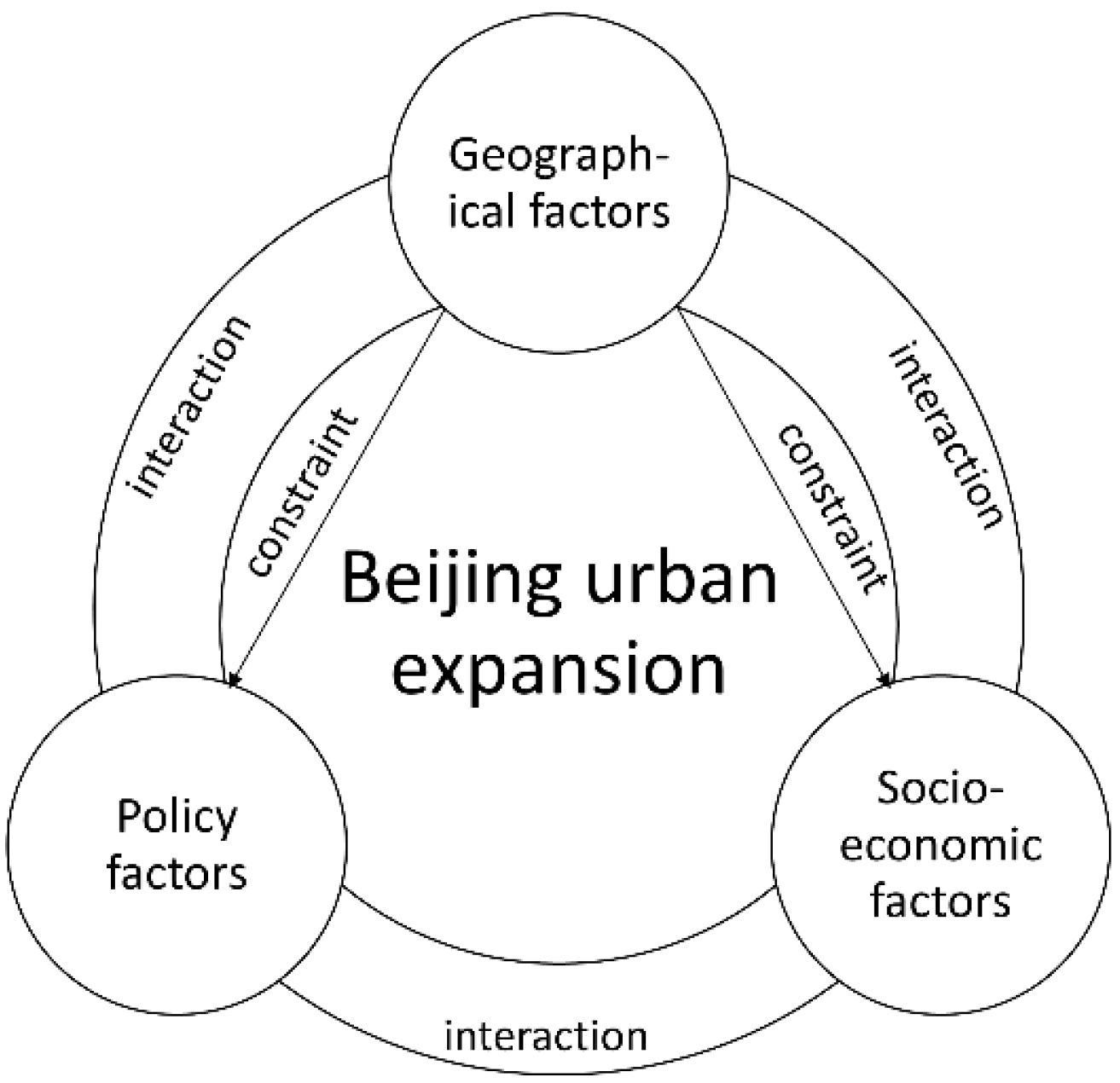
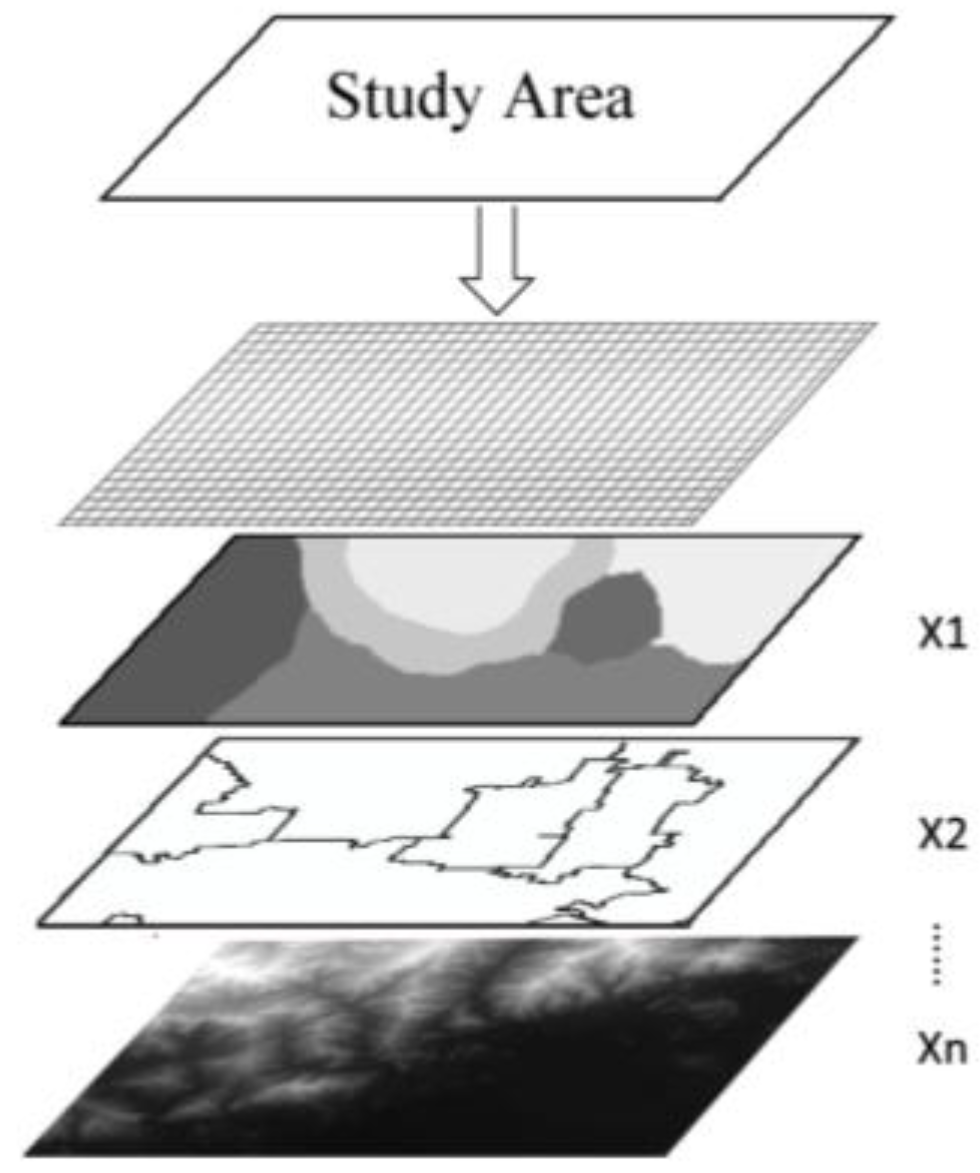
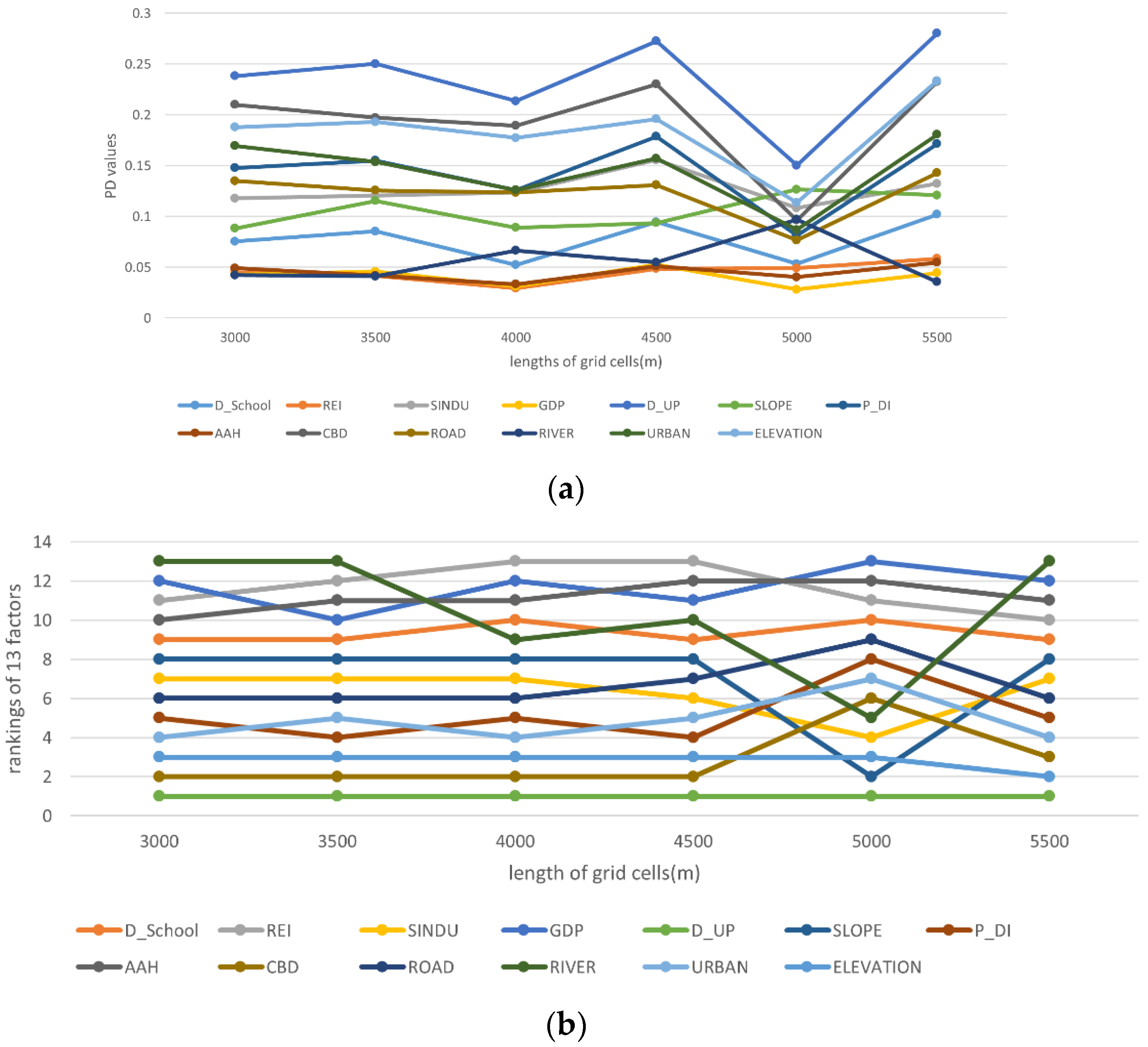
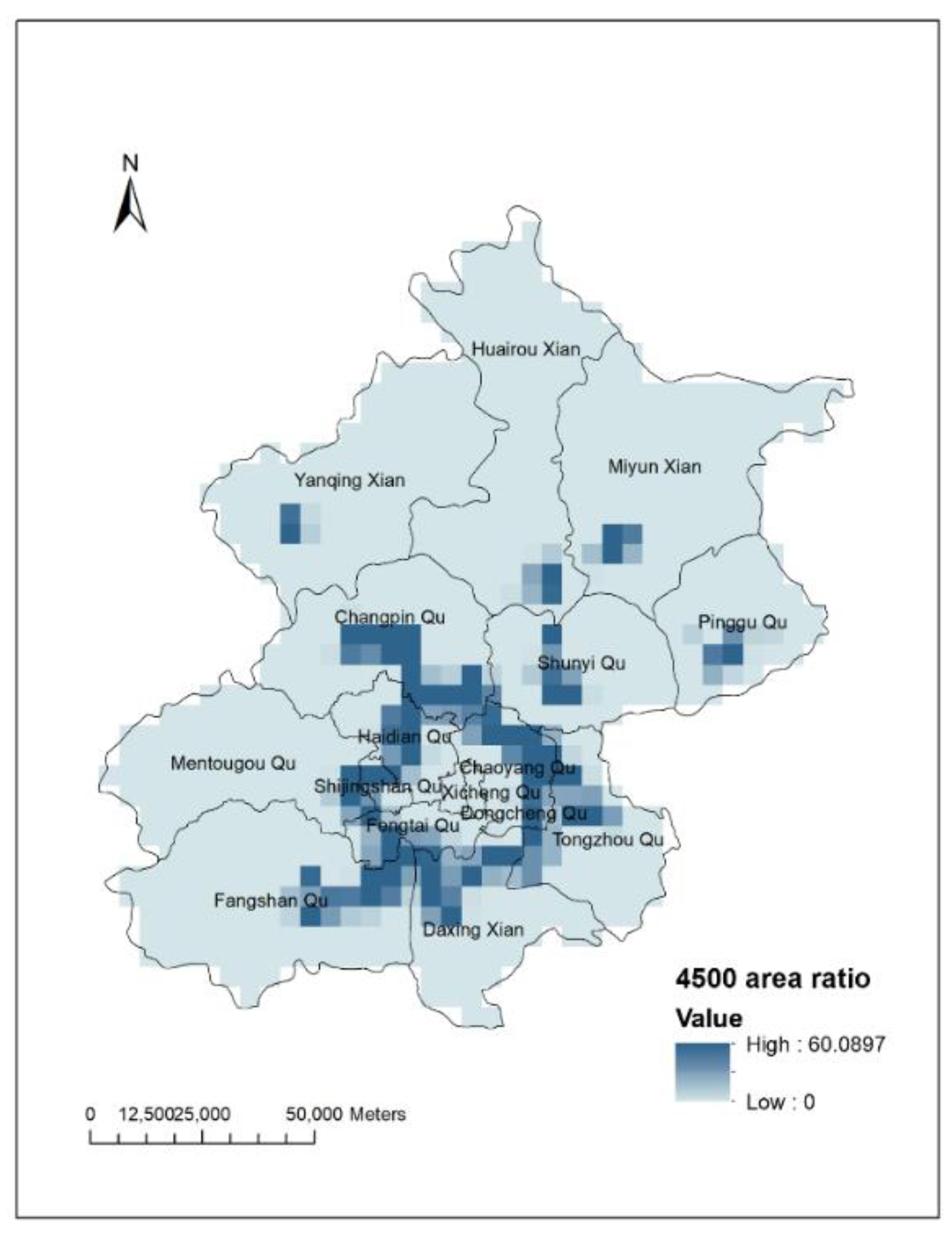
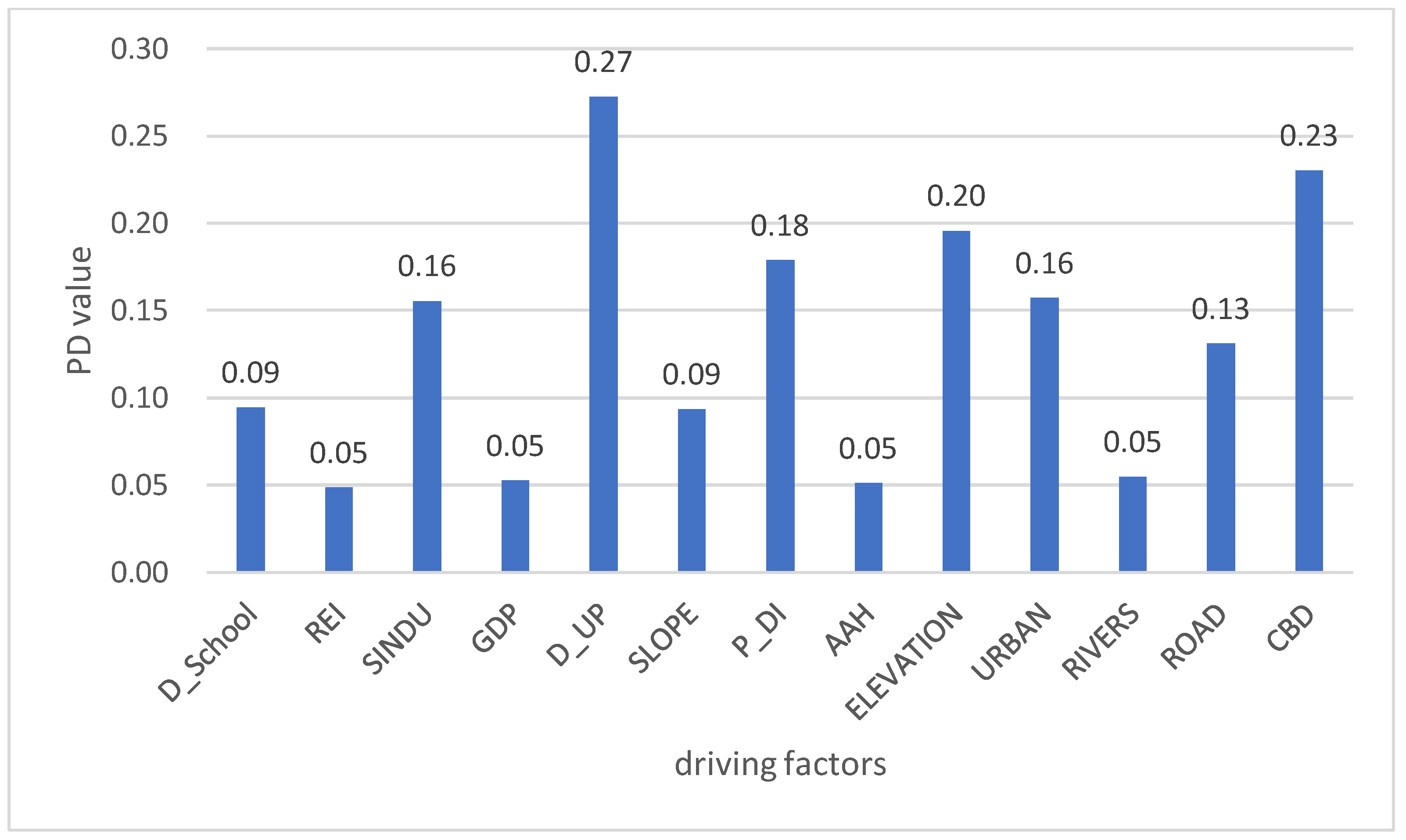
| Category | Factors in GeoDetector | Abbreviation |
|---|---|---|
| Geographical factors | Elevation | Elevation |
| Slope | Slope | |
| Distance to rivers | River | |
| Distance to the CBD | CBD | |
| Socioeconomic factors | Change in the secondary industry in GDP between 2010 and 2015 | SINDU |
| Change in GDP between 2010 and 2015 | GDP | |
| Change in real estate investment between 2010 and 2015 | REI | |
| Change in disposable income per citizen between 2010 and 2015 | P_DI | |
| Change in area of housing construction between 2010 and 2015 | AAH | |
| Policy factors | Growth of urban land | Urban |
| Distance to primary roads | ROAD | |
| Change in urban population density between 2010 and 2015 | D_UP | |
| Distance to primary and middle school | D_School |
| Factors | Classification | Average Urban Expansion Ratio |
|---|---|---|
| ELEVATION (m) | 0–200 | 10.64 |
| 200–500 | 0.26 | |
| 500–800 | 0.57 | |
| 800–1000 | 0.00 | |
| 1000–2283 | 0.00 | |
| SLOPE (degree) | 0–5 | 9.36 |
| 5–10 | 2.22 | |
| 10–15 | 0.44 | |
| 15–25 | 0.20 | |
| 25–68.89 | 0.05 | |
| RIVER (m) | 0–2 | 3.78 |
| 2–4 | 4.85 | |
| 4–8 | 6.27 | |
| 8–12 | 7.11 | |
| 12–20 | 11.10 | |
| ROAD (km) | 0–3 | 9.54 |
| 3–7 | 0.26 | |
| 7–12 | 0.00 | |
| 12–20 | 0.00 | |
| 20–35 | 0.00 | |
| CBD (km) | 0–20 | 12.41 |
| 20–40 | 8.34 | |
| 40–60 | 3.42 | |
| 60–80 | 1.15 | |
| 80–120 | 0.04 |
| Policy Factors | Socioeconomic Factors | Geographical Factors | |||||||||||
|---|---|---|---|---|---|---|---|---|---|---|---|---|---|
| URBAN | ROAD | D_School | D_UP | GDP | P_DI | SINDU | AAH | REI | ELEVATION | SLOPE | RIVER | CBD | |
| URBAN | |||||||||||||
| ROAD | 0.2476 | ||||||||||||
| D_School | 0.2574 ∥ | 0.2682 ∥ | |||||||||||
| D_UP | 0.3284 | 0.3008 | 0.3880 ∥ | ||||||||||
| GDP | 0.2469 ∥ | 0.2182 ∥ | 0.1394 | 0.3721 ∥ | |||||||||
| P_DI | 0.3014 | 0.2573 | 0.3391 ∥ | 0.3651 | 0.3058 ∥ | ||||||||
| SINDU | 0.2613 | 0.2880 | 0.2235 | 0.3541 | 0.3427 ∥ | 0.3216 | |||||||
| AAH | 0.2147 ∥ | 0.2252 ∥ | 0.1504 ∥ | 0.3558 ∥ | 0.1655 ∥ | 0.3278 ∥ | 0.1975 | ||||||
| REI | 0.1973 | 0.2091 ∥ | 0.1178 | 0.3146 | 0.0736 | 0.2594 ∥ | 0.1638 | 0.0614 | |||||
| ELEVATION | 0.2181 | 0.2738 | 0.2946 ∥ | 0.3404 | 0.2672 ∥ | 0.3215 | 0.2735 | 0.2333 | 0.2076 | ||||
| SLOPE | 0.2220 | 0.176 | 0.3202 ∥ | 0.3487 | 0.2914 ∥ | 0.3943 * | 0.3305 ∥ | 0.2900 ∥ | 0.2046 ∥ | 0.2592 | |||
| RIVER | 0.2480 ∥ | 0.1938 ∥ | 0.2083 ∥ | 0.2934 | 0.1891 ∥ | 0.2024 | 0.2503 ∥ | 0.2136 ∥ | 0.1578 ∥ | 0.2724 ∥ | 0.1689 ∥ | ||
| CBD | 0.3617 | 0.3278 | 0.3155 | 0.3919 * | 0.2792 | 0.3164 | 0.4359 *,∥ | 0.3083 ∥ | 0.2504 | 0.3905 | 0.3385 ∥ | 0.2769 | |
© 2018 by the authors. Licensee MDPI, Basel, Switzerland. This article is an open access article distributed under the terms and conditions of the Creative Commons Attribution (CC BY) license (http://creativecommons.org/licenses/by/4.0/).
Share and Cite
Xu, Q.; Zheng, X.; Zhang, C. Quantitative Analysis of the Determinants Influencing Urban Expansion: A Case Study in Beijing, China. Sustainability 2018, 10, 1630. https://doi.org/10.3390/su10051630
Xu Q, Zheng X, Zhang C. Quantitative Analysis of the Determinants Influencing Urban Expansion: A Case Study in Beijing, China. Sustainability. 2018; 10(5):1630. https://doi.org/10.3390/su10051630
Chicago/Turabian StyleXu, Qiurong, Xinqi Zheng, and Chunxiao Zhang. 2018. "Quantitative Analysis of the Determinants Influencing Urban Expansion: A Case Study in Beijing, China" Sustainability 10, no. 5: 1630. https://doi.org/10.3390/su10051630





